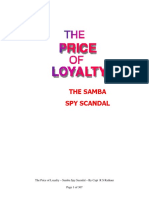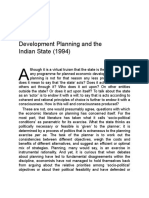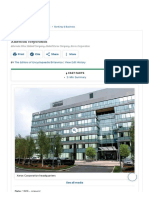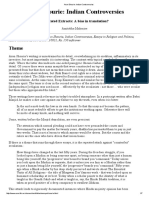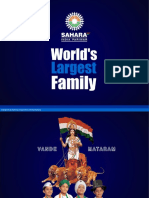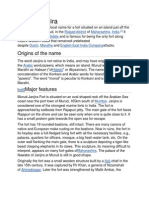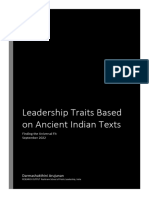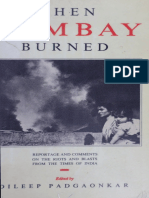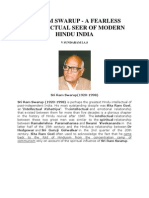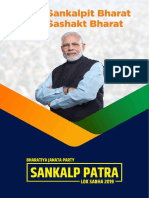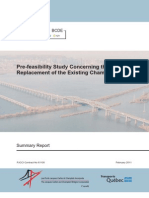Book
Book
Uploaded by
amit_sachdevaCopyright:
Available Formats
Book
Book
Uploaded by
amit_sachdevaOriginal Title
Copyright
Available Formats
Share this document
Did you find this document useful?
Is this content inappropriate?
Copyright:
Available Formats
Book
Book
Uploaded by
amit_sachdevaCopyright:
Available Formats
(This is an extract from Chapters 3, 4,5 & 6 of the book covering the initial years – the relatively distant
past that otherwise exists in fading memories and sepia prints.)
book extract
Founder Raghunandan Saran at his desk.
Moving India on Wheels – The story of Ashok Leyland by S Muthiah and K N Gopalan
P
yare Lal was born into a merchant family in Ghaziabad. But when it came
to spreading his wings in the first half of the 20th Century, he struck out
on his own and established dealerships and workshops in Lahore and
Rawalpindi (both now in Pakistan) for Austin cars. While the eldest son,
Raghubir Saran, looked after the family’s Delhi interests, the youngest Raghunan-
dan Saran, followed his father’s lead and joined the march on the troubled road to
freedom. He was educated at St. Stephen’s College and then went to Cambridge
to study at Fitzwilliam House. On his return to India, he fell under the spell of the
freedom movement. As participating in it would go contrary to his family’s business
interests, he disassociated himself from the family business, took up a job as a
schoolteacher and became active in the movement. His family saw little of him in
those days, not only at home but also during those several occasions he was lodged
in jail between 1942 and 1945.
Once freedom was won, Jawaharlal Nehru, his friend and leader, persuaded him
that he would be able to do more for nation-building through developing industry,
in which India’s future lay, than by getting into politics and joining the Congress
government.
Whereupon, it is related, he sold some of his personal assets in Delhi to enable
him to enter industry.
Independence and Partition brought Pyare Lal & Sons (EP) Ltd. to Delhi, but
Government’s approach to industry took Raghunandan Saran to the South.
In the decade before Independence, a few companies had begun to assemble
motor vehicles in India, importing completely knocked down (CKD) kits. But an
Independent India saw this as only a prelude to the development of a full-fledged,
indigenous automobile industry. One who was in total agreement with this policy was
Saran. Familiar as he was with Austin Motors Ltd., he decided to use his contacts with
them and negotiate for the assembly and manufacture of Austin cars in India.
In December 1946, he led a delegation of leading Indian Austin distributors to
Britain and there they signed an agreement with the Austin Motor Export Corporation
for its cars to be initially assembled, and thereafter to be manufactured, in India. The
agreement provided for a production plant in one of India’s port cities and for the
production of a minimum of 3,000 cars yearly. Production was expected to begin
within a year based on a plan which had been formulated before the War.
A.R. Wadia of Bombay, Md. Hussain of Madras, Ganguli from Hyderabad, and Haia-
dulla of Uttar Pradesh, all importers of Austin cars, agreed to join him in forming a com-
pany to be called Ashok Motors Limited, the name chosen being that of Raghunandan
Saran’s son. Saran was unanimously appointed Managing Director of the Company.
Ashley News / June 2008 10
The Company decided to establish its factory in Bombay State on land Saran
book extract
had bought in Bhandup, near Thana. But before any progress could be made,
Government expressed the view that there should be only one car factory in each
part of the country where there was a major port - and Bombay already had Pre-
mier Automobiles in business. So, Ashok Motors moved to the fishing village of
Ennore, just north of Madras, where the Company acquired 124 acres of land from
R. Narayanaswamy Pillai for Rs. 99,271-12-0. Saran paid Rs. 74,000 of this, plus
expenses from his pocket.
Ashok Motors was given its certificate of incorporation on September 7, 1948 in
Madras and commenced business on December 14th. On October 26th, the Com-
pany announced that it had been formed to carry on the assembly, manufacture and
trade in motor cars, motor buses, lorries and trucks and all kinds of motor vehicles,
their parts, components and accessories.
The Company planned to import the A-40 and A-70 Austin cars in knocked down
condition and assemble them in India as a first step and then progressively get into
manufacture of the vehicles. Imported components were initially stored in MCt.M.
Chidambaram Chettyar’s warehouses in Mount Road – where even initial assembly
began, it is narrated – and transported to Ennore when needed as the factory build-
ing came up stage by stage.
Prime Minister Jawahar Lal Nehru, B. Vijay Reddy (Ashok Leyland), B.K. Bedi (Global Motors) on extreme right and Rajiv
and Sanjay Gandhi (Nehru’s grandsons) inside India’s first airconditioned coach built in 1961 on a Comet Chassis.
In September 1949, production began in Ennore with the help of Austin Motors
Limited and Austin Motors Export Corporation Limited, UK, who sent out engineers
to train the workforce and supervise production.
When the financial results for the period September 7, 1948 - December 31, 1949
were announced, the turnover proved to be an impressive Rs. 350,000, despite the
industrial conditions of the times, when allotment of import licences by Government
was meagre despite all its promises of commitment to the motor industry.
Even before assembly of Austins in Madras had got into full swing, Saran was
thinking ahead. In January 1949, he began negotiations with Leyland Motors Ltd.,
U.K., for distribution, assembly and progressive manufacture of the Leyland range of
commercial vehicles. The negotiations dragged on and it was 1950 before agreement
was reached with Leyland Motors Limited, U.K., and Ashok Motors got sole rights to
import, assemble and progressively manufacture Leyland trucks for seven years.
11 Ashley News / June 2008
book extract
Comet chassis assembly conveyor on the left; heavy The entire factory, staff and workers, turned out in 1949
duty chassis assembly on the right. to deliver the first A 40 assembled by Ashok Motors.
1950 was Ashok Motors’ first full year of production. In 1950-51, the Mangalore Tile
Factory purchased four Comet 350-engined tippers, which were assembled by Ashok
Motors and delivered in Mangalore. These were the first Leyland chassis assembled by
Ashok Motors in Ennore.
The introduction of the Industries Development and Regulations Act in 1951 was a
landmark in industrial legislation in India. It vested the Government with the powers to
regulate and control existing and future industries.
Ashok Motors was required to submit a manufacturing programme by the end of Sep-
tember 1953 for commercial vehicles of five-ton and upwards, diesel engines suitable
for three-ton commercial vehicles, a Jeep type of vehicle subject to Army approval after
tests, a baby car and a medium car of a type not to be manufactured by other approved
manufacturers.
But before matters could move further, the Company sustained a major loss when
Raghunandan Saran, the promoter, died in an aircrash at Nagpur on December 12, 1953,
while returning from Delhi. That was a great blow to the Company as he had been solely
responsible not only for its establishment but for continuously striving to arrange a suitable
foreign collaboration that would enable setting up a manufacturing unit acceptable to the
Government of India.
It was Saran who had the vision to plunge into the commercial vehicle manufacturing
industry at a time when the buses in use on the roads were mostly imported ones, where,
for goods transportation, movement by goods trains was preferred, and where the permit-
ted gross vehicle weight was restricted to 9 tonnes. It was also a time when Indian invest-
ment was limited to a few affluent persons and some Indian royalty. It was his personal
influence and contacts that had been able to attract investment in Ashok Motors from his
fellow Indians.
The Board, replying to a Government of India’s letter of March 1, 1954, confirmed that
Ashok Motors would implement the programme for the manufacture of the Leyland five-
ton Comet (passenger and goods types) in India in technical collaboration with Leyland
Motors Limited, U.K.
A licence for the manufacture of 1000 Comets a year was granted. With Leyland Motors
Ltd., Leyland, U.K., coming forward “generously with financial and technical assistance to
implement the Progressive Manufacturing Scheme and with their active participation, we
can confidently foresee a very bright future for the Company,” the Board recorded.
At a meeting held in Hyderabad on February 25, 1955, the Ashok Motors Board decided
that Ashok Motors would shortly go into voluntary liquidation and a new company called
Ashok Leyland Limited formed. The new company would take over the assets of Ashok
Motors Limited at par. All shareholders in Ashok Motors Limited were to be invited to sur-
render their shares at par for reinvestment in Ashok Leyland Limited, also at par.
On July 4, 1955 Ashok Motors Ltd. became Ashok Leyland Ltd.
Ashley News / December 2008 12
book extract
The Hinduja brothers: Srichand P. Hinduja (seated) The Hinduja/Iveco team going around the Ennore factory
and (standing left to right): Gopichand P.Hinduja, during their visit to Chennai in 1987.
Prakash P. Hinduja and Ashok P. Hinduja
The following extract from chapters 5 and 6 offer some rare insights into a major turning
point: the entry of the Hinduja Group in the late 80s.
T he process of privatisation of the British industry was started by Prime Minister Margaret
Thatcher and the commercial vehicle business of British Leyland was chosen as the
first target for privatisation from within the UK auto industry. Ashok Leyland, being part of
the commercial vehicle Leyland group in the UK, did not attract any interest at the time, as
India was a relatively unknown investment destination. Though the UK commercial vehicle
business was privatised, Ashok Leyland remained attached to the Rover Group which, by
then, consisted only of the car segment in the UK. In 1987, the Rover Group decided to
privatise its holding in Ashok Leyland and Ennore Foundries and, accordingly, bids were
invited.
It was around this time that S P Hinduja and G P Hinduja happened to meet Lord Young,
the then Secretary of Trade & Industry in the Margaret Thatcher Cabinet, on another matter.
During the course of the conversation, Lord Young mentioned that the Government was
planning to privatise British Leyland and its subsidiaries in various parts of the world. The
information aroused the interest of the brothers. Their subsequent enquiries revealed that
a number of Indian industrialists, including the late Manu Chhabria, Rahul Bajaj and Hari
Singhania, were using a battery of global merchant bankers and law firms to make bids
for Ashok Leyland. The Hinduja family decided to put in its own bid. As SP was in New
York on work, GP and his team of in-house advisors, including Firooz Sahami and Herbert
Klingele, met those in charge of the disinvestment of British Leyland. GP was asked who
the Group’s merchant bankers and lawyers were. He responded that he and his in-house
team were there to make a firm offer to acquire the entire holding of LRLIH in Ashok Leyland
Limited on immediate payment.
Put off by the size of the Ashok Leyland workforce and by a fear of Indian con-
ditions, DAF of the Netherlands, who acquired the British Leyland commercial
vehicle stake, and other foreign vehicle manufacturers did not bid for the Indian
Company. The Hindujas, who understand Indian conditions well, made their bid
with a Fiat Group company, the Fiat Group having had long manufacturing experi-
ence in India. Cummins of the US at this point offered to team with the Hindujas.
But S.P. Hinduja turned down the offer saying “Our word is our bond,” referring to
the near-closure of agreement with IVECO.
13 Ashley News / December 2008
One major condition put by the British Government, the then ultimate owner of LRLIH
book extract
Ltd, was that the new owner must have in his own right, or through a partner, not only
the technical expertise to run a commercial vehicle factory as well as the capability,
financially and technically, to do so, but also the intention to develop Ashok Leyland
and Ennore Foundries further. The seller also wished that the new owner would leave the
management undisturbed, as both management and employees had proved capable
and successful in the past. GP assured them on both counts.
There were several interested vehicle manufacturers, among them IVECO, Mack,
and MAN, who approached the Hindujas and offered to partner them. For the Hinduja
Group, IVECO was the ideal choice, having the required technology, the willingness to
part with it, and to define itself as a technical partner. The Hinduja family and IVECO also
knew and respected each other from a previous business relationship of the Hinduja
Group in Iran with Magirus Deutz, later a part of IVECO. So, the Hinduja brothers and
IVECO agreed to jointly buy LRLIH.
The Hindujas remained true to the commitment made in London once they entered
Ashok Leyland. During the last two decades they have fully supported the manage-
ment, initially headed by Shahaney and later by Seshasayee. The Company, which had
been starved of investment and technology, has, from the very start, benefited from the
takeover which broadly coincided with the era of economic liberalisation in India, thus
ensuring the Company’s march towards accelerated growth.
Carrying more than 300 rare photographs, the book is also sprinkled with
interesting nuggets like these two:
Robin Jones, who joined as technician-cum-General Manager in 1959, was very
particular about keeping the shop clean. He used to go from place to place in
the factory and offices and pull up people for untidiness. He decided to form
a cleaning wing in the factory, appointed an unskilled worker to be in charge
of the cleaning operations, and called him the ‘Solvex King’. The ‘Solvex King’
used to take tremendous pride in keeping the machine shop clean, with white
lines down the floor.
Roy Hoyle, who joined along with Robin Jones, as Works Manager was a
stickler for the rules of admission into the factory and on one occasion
Mrs. Lal Bahadur Shastri, the then Union Home Minister’s wife, was refused
admission onto the shop floor as she was wearing a saree. Collins (then MD)
had to write a letter of apology to the Minister. Shastri’s son Harikrishna was
working with Ashok Leyland in Madras at the time and, later, in Delhi.
Ashley News / December 2008 14
You might also like
- The Price of Loyalty SAMBA SPY Scandal PDFDocument307 pagesThe Price of Loyalty SAMBA SPY Scandal PDFdnbatsa100% (1)
- Development Planning and The Indian State - ChatterjeeDocument28 pagesDevelopment Planning and The Indian State - ChatterjeeAsrar AhmedNo ratings yet
- Xerox - History, Products, & Facts - BritannicaDocument8 pagesXerox - History, Products, & Facts - BritannicanguyentuandangNo ratings yet
- Arun Shourie - Indian Controversies PDFDocument7 pagesArun Shourie - Indian Controversies PDFBrij SinghNo ratings yet
- Fall of The Mughal Empire Vol II 1754 - 1771Document584 pagesFall of The Mughal Empire Vol II 1754 - 1771qayamat4x450% (2)
- Red Star Over West Bengal by Ram SwarupDocument20 pagesRed Star Over West Bengal by Ram SwarupManasNo ratings yet
- Ahmedabad Rath YatraDocument5 pagesAhmedabad Rath YatraManish JhaNo ratings yet
- 10 - Chapter 5 Critical Analysis of Valmiki Ramayana and Its Implications To Educational LeadershipDocument154 pages10 - Chapter 5 Critical Analysis of Valmiki Ramayana and Its Implications To Educational LeadershipAmit BassiNo ratings yet
- The Murder of The MahatmaDocument65 pagesThe Murder of The Mahatmavganapathy1000No ratings yet
- The Curious Case of The Congress PartyDocument8 pagesThe Curious Case of The Congress PartyRabiaNo ratings yet
- B737 Tire FailuresDocument3 pagesB737 Tire FailuresRushabhPatel100% (2)
- Morbi ReportDocument15 pagesMorbi Reportmeetkalola18No ratings yet
- Hunar Se Rozgar - Cooks: SR - No Name AddressDocument26 pagesHunar Se Rozgar - Cooks: SR - No Name Addressshravan AnvekarNo ratings yet
- Presentation of Sahara India PariwarDocument47 pagesPresentation of Sahara India PariwarprobalkumardebnathNo ratings yet
- MurudDocument2 pagesMurudmehulpawar123No ratings yet
- Morarji Desai - My True FriendDocument8 pagesMorarji Desai - My True FriendFriends of Dr. SwamyNo ratings yet
- Srishti Dokras Architect: Janjira FortDocument47 pagesSrishti Dokras Architect: Janjira FortUday DokrasNo ratings yet
- Damodaram Sanjivayya National Law UniversityDocument20 pagesDamodaram Sanjivayya National Law UniversitySusmita TripathyNo ratings yet
- India's Dirty Hand in Maldivian PoliticsDocument5 pagesIndia's Dirty Hand in Maldivian PoliticsRumaalu20% (2)
- Dhananjay Keer - Life of Swatantryaveer V. D. SavarkarDocument58 pagesDhananjay Keer - Life of Swatantryaveer V. D. SavarkarScribd Giveaway100% (2)
- Indira GandhiDocument622 pagesIndira Gandhihareemehu2024No ratings yet
- The Battle of Islamgarh Fort, 1971Document3 pagesThe Battle of Islamgarh Fort, 1971SHTF 555No ratings yet
- Caste and Political Leadership in Maharashtraa Review and Current AppraisalDocument4 pagesCaste and Political Leadership in Maharashtraa Review and Current AppraisalVasan KulkarniNo ratings yet
- Godse NathDocument43 pagesGodse NathjadigeetaNo ratings yet
- Autobiagraphy of Joyti BasuDocument183 pagesAutobiagraphy of Joyti Basukaustavmukherjee1978No ratings yet
- Lal Bahadur Shastri - A Brief HistoryDocument15 pagesLal Bahadur Shastri - A Brief HistoryNandeesha RameshNo ratings yet
- India’s Moonshot: How Ambition, Engineering and Imagination Put India on the South Pole of the Moon. A Chapter Book for Smart MindsFrom EverandIndia’s Moonshot: How Ambition, Engineering and Imagination Put India on the South Pole of the Moon. A Chapter Book for Smart MindsNo ratings yet
- Kartar Singh SarabhaDocument10 pagesKartar Singh SarabhaSoorya Vansham100% (1)
- Chathiyude Padmavyooham NewsDocument21 pagesChathiyude Padmavyooham NewsPrasanth SivanandanNo ratings yet
- Remembering Bajirao Peshwa - I: HinduDocument10 pagesRemembering Bajirao Peshwa - I: HindusamNo ratings yet
- The Inscrutable Politics of Subramanian SwamyDocument18 pagesThe Inscrutable Politics of Subramanian SwamyFriends of Dr. SwamyNo ratings yet
- Illegal Immigration From BangladeshDocument120 pagesIllegal Immigration From BangladeshKarthik VMSNo ratings yet
- Trail of the Tiger: Uddhav Balasaheb Thackeray: A JourneyFrom EverandTrail of the Tiger: Uddhav Balasaheb Thackeray: A JourneyNo ratings yet
- Leadership Traits Based On Ancient Indian TextsDocument23 pagesLeadership Traits Based On Ancient Indian Textsnitant1411No ratings yet
- Submitted To: Prof. Kalyan AggarwalDocument8 pagesSubmitted To: Prof. Kalyan Aggarwalsi ranNo ratings yet
- Some Aspects of Religion and Politics in India During The 13th Century - TextDocument463 pagesSome Aspects of Religion and Politics in India During The 13th Century - TextTanisha BhatiaNo ratings yet
- Rohana Wijeweera The Killing of Sri Lanka's Stalinist IconDocument6 pagesRohana Wijeweera The Killing of Sri Lanka's Stalinist IconThavam RatnaNo ratings yet
- The Revolutionary Movement in India - EssayDocument14 pagesThe Revolutionary Movement in India - EssaymitulNo ratings yet
- Master Tara Singh and Nehru Report-1928Document24 pagesMaster Tara Singh and Nehru Report-1928Dr Kuldip Singh DhillonNo ratings yet
- Gods and Godmen of India PDFDocument3 pagesGods and Godmen of India PDFSean0% (2)
- Hindu Rashtra Darshan by Veer Vinayak Damodar SavarkarDocument130 pagesHindu Rashtra Darshan by Veer Vinayak Damodar SavarkarArya Veer100% (3)
- When Bombay Burned - Padgaonkar, Dileep, (Ed - ) Laxman, R - K - (Ill - ) - 1993 - U - B - S - Publishers' DistrDocument334 pagesWhen Bombay Burned - Padgaonkar, Dileep, (Ed - ) Laxman, R - K - (Ill - ) - 1993 - U - B - S - Publishers' Distrmahwish16haqueNo ratings yet
- Azad KashmirDocument12 pagesAzad KashmirJackNo ratings yet
- The Hindu Code BillDocument5 pagesThe Hindu Code BillHarjeet SinghNo ratings yet
- 7th RN Kao Memorial Lecture by Former President APJ Abdul KalamDocument6 pages7th RN Kao Memorial Lecture by Former President APJ Abdul KalamCanary TrapNo ratings yet
- India-At-75-8.14.22 FINALDocument145 pagesIndia-At-75-8.14.22 FINALsalil61No ratings yet
- False Allies Indias Maharajahs in the Age of Ravi Varma by Manu S Pillai Z-lib.orgDocument527 pagesFalse Allies Indias Maharajahs in the Age of Ravi Varma by Manu S Pillai Z-lib.orgnikita.mamtoraNo ratings yet
- SRI RAM SWARUP Vande Matram TranslationDocument38 pagesSRI RAM SWARUP Vande Matram Translationआनंद गुप्ताNo ratings yet
- The Indian National Congress Controversies and CriticismsDocument23 pagesThe Indian National Congress Controversies and CriticismsMindjoltNo ratings yet
- Constitutional Foundation of Secularism by Subramanian SwamyDocument73 pagesConstitutional Foundation of Secularism by Subramanian SwamyFriends of Dr. SwamyNo ratings yet
- Comparative Study B.R. Ambedkar and Mahatma Gandhi: IntrodutionDocument8 pagesComparative Study B.R. Ambedkar and Mahatma Gandhi: IntrodutionSharvi SharmaNo ratings yet
- Robert Desmond King, Nehru and The Language Politics of IndiaDocument288 pagesRobert Desmond King, Nehru and The Language Politics of IndiaUpasana NehraNo ratings yet
- Nana FadnavisDocument4 pagesNana FadnavisVatsala TamhaneNo ratings yet
- Charan Singh - The Most Misunderstood GiantDocument7 pagesCharan Singh - The Most Misunderstood GiantFriends of Dr. SwamyNo ratings yet
- BJP Manifesto 2019Document45 pagesBJP Manifesto 2019The Wire100% (4)
- Rajaji PDFDocument14 pagesRajaji PDFraghunathanNo ratings yet
- Indore Nagpur: Departure ArrivalDocument2 pagesIndore Nagpur: Departure ArrivalAnurag jainNo ratings yet
- New Champlain Bridge: Final Report Summary (English)Document82 pagesNew Champlain Bridge: Final Report Summary (English)andyrigaNo ratings yet
- Business Proposal For An Integrated Agro Based FoodDocument30 pagesBusiness Proposal For An Integrated Agro Based FoodSurajit SarkarNo ratings yet
- Địa chỉ: Tòa nhà H10, Ngõ 475 Nguyễn Trãi, Thanh Xuân, Hà Nội Điện thoại: 1900966947/ Email: tienganhthucchien@stp.edu.vn WebsiteDocument6 pagesĐịa chỉ: Tòa nhà H10, Ngõ 475 Nguyễn Trãi, Thanh Xuân, Hà Nội Điện thoại: 1900966947/ Email: tienganhthucchien@stp.edu.vn WebsiteTùng ZNo ratings yet
- 3.5 PedestrianFacilities FinalReviewDraftDocument16 pages3.5 PedestrianFacilities FinalReviewDraftdanisNo ratings yet
- ServiceDocument78 pagesServiceЕвгений SNo ratings yet
- ADVICS Brake Pads Catalog 2018Document84 pagesADVICS Brake Pads Catalog 2018MatveyShNo ratings yet
- Start-Up & Shut Down Procedures: Underground LoadersDocument1 pageStart-Up & Shut Down Procedures: Underground LoadersJoel Rodríguez100% (1)
- 1984 RTD Bus Service Guide To The 1984 OlympicsDocument16 pages1984 RTD Bus Service Guide To The 1984 OlympicsMetro Los AngelesNo ratings yet
- Checklist For IRC SP 73 - 2018Document5 pagesChecklist For IRC SP 73 - 2018gdrplgudcpmcNo ratings yet
- Porter - S Diamond CaseDocument1 pagePorter - S Diamond CaserfhunxaieNo ratings yet
- OOCL IMPORT IHL Charges INDIA OOCL - INFONET - EFFECTIVE FROM JANUARY 2024Document54 pagesOOCL IMPORT IHL Charges INDIA OOCL - INFONET - EFFECTIVE FROM JANUARY 2024doquanghuy267No ratings yet
- BMW 330dDocument1 pageBMW 330dsumit15509270No ratings yet
- Hornback CatalogueDocument1 pageHornback Cataloguepramod.kumarsinghNo ratings yet
- Group 2 (Buatan Port)Document11 pagesGroup 2 (Buatan Port)imeldaelisabeth0% (1)
- TCASDocument3 pagesTCASCarolina TavaresNo ratings yet
- Speed, Distance and TimeDocument3 pagesSpeed, Distance and Timechi.ntt2001No ratings yet
- ZL50CN Tier II GCICDocument2 pagesZL50CN Tier II GCICViet Quang DoanNo ratings yet
- Book Review: Book Name: TATA NANO The People's Car Author: Pradeep Thakur About The AuthorDocument2 pagesBook Review: Book Name: TATA NANO The People's Car Author: Pradeep Thakur About The AuthorsumapriyabattulNo ratings yet
- G.R. No. 125948 December 29, 1998 First Philippine Industrial Corporation, Petitioner, .Court of AppealsDocument19 pagesG.R. No. 125948 December 29, 1998 First Philippine Industrial Corporation, Petitioner, .Court of AppealsMicah Clark-MalinaoNo ratings yet
- FSFDSDSFSDFDocument141 pagesFSFDSDSFSDFONURNo ratings yet
- Medford - Complete - Streets - Policy - Final Edits - Ready For MassDOT - 4-21-16Document4 pagesMedford - Complete - Streets - Policy - Final Edits - Ready For MassDOT - 4-21-16alexruppenthalNo ratings yet
- Traffic Control Devices - Part 2Document12 pagesTraffic Control Devices - Part 2reashmapsNo ratings yet
- Air Cargo Freight ForwardersDocument7 pagesAir Cargo Freight ForwarderswilliamlyeNo ratings yet
- WB B2 GT Unit 3Document12 pagesWB B2 GT Unit 3SamahNo ratings yet
- 06 Towing and Taxiing (ATA 09) - TXI - 12 2021 - 31991Document6 pages06 Towing and Taxiing (ATA 09) - TXI - 12 2021 - 31991Chaidir AljarwizharNo ratings yet
- Nissan Truck PDFDocument3 pagesNissan Truck PDFKamal SemboyNo ratings yet
- Opening of Public Carriage of Passenger Rules 2023Document67 pagesOpening of Public Carriage of Passenger Rules 2023shivlucky16No ratings yet
- S.No NCO Code Sector Name Family Name Job Role / OccupationDocument21 pagesS.No NCO Code Sector Name Family Name Job Role / OccupationJoelNo ratings yet

